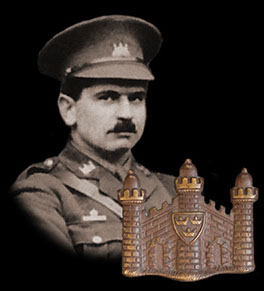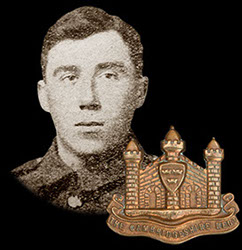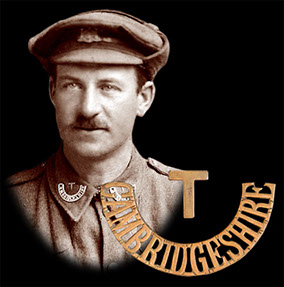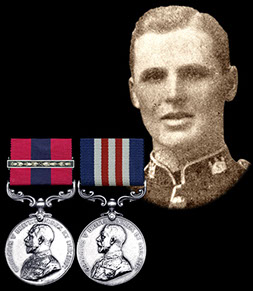
Who Were
The Cambs
The Cambs
at War
1/1st Btn 1914-1919
1914 - 1/1st Overview
1915 - 1/1st Overview
1915 - St Eloi
1915 - Fosse Wood
1916 - 1/1st Overview
1916 - The Schwaben
1916 - St Pierre Divion
1917 - 1/1st Overview
1917 - St Julien
Insignia, Medals & Books
Remembering The Cambs
Biographies
About Us &
This Site
The Return to Ypres - Fattening Up for Spring - November 1916 to March 1917
Following its part in the fighting at St Pierre Divion in the Ancre valley near Thiepval on November 13, 1916, the 1/1st Cambridgeshires, along with the rest of 39th Division, came out of the line ready to leave the Somme behind.
The battalion marched to Doullens and was then taken by train to Poperinghe, near Ypres, the area where the Cambridgeshires had first gone into the line in early 1915. Temporary command of the battalion was now in the capable hands of Major John Allin Methuen DSO, of 17th King’s Royal Rifles, a South African mining engineer, who held the position until the commanding officer Lt-Col Ted Riddell’s returned in February 1917.
Arriving to take up the post of second in command on November 19 was Major George Brimley Bowes, who had been a pre-war officer with the battalion. With his father, he ran the Bowes & Bowes publishing company in Cambridge, which in 1934 would print the history of the Cambridgeshire Regiment. His short time with the battalion was not without controversy. He sustained an accidental wound while supervising a bombing practise, which resulted in a Court of Inquiry. Bowes, who was considered to be in disgrace as a result, was not blamed, but was severely reprimanded and his days with the battalion were numbered. Soon he was moved from the battalion to be attached to Corps staff to organise delousing and sanitary work in Poperinghe. During this time he became involved in the management of Talbot House at Poperinghe, and after the war founded the Cambridge branch of Toc H.
In January 1917 the vacancy for a 2ic saw the return to the 1/1st Battalion from the 3/1st Battalion in England of Major Muirhead Collins Clayton, of Wisbech, who had been wounded in 1915. But his tenure did not last due the surprise return of Major Edward T Saint, another original from 1915, who arrived to be 2ic on March 27, 1917. Saint had commanded the 4/1st Battalion in England, but in November 1916 was posted to a shortlived command of the 16th Cheshires in 35th Division before being posted to command a divisional training school at Boves, before his return to 1/1st Cambs. Clayton was moved first to command B Coy and then to adjutant. Both men would later command the battalion.
In the regimental history (The Cambridgeshires 1914-19), Clayton writes:
The battalion was working alternately with the Hertfordshires in holding the line at Wieltje, five days in the line and then five days in support at the Canal Bank. When in the line Battalion HQ was at St Jean; the front trenches were good, with long communication trenches.
It was a quiet time as opposing sides prepared for renewed fighting in the spring. The men spent their time repairing trenches damaged by shellfire and winter conditions, on working parties and patrols or raids to gain information about German activity. As Riddell stated in the regimental history:
The opposing forces were being fattened up in anticipation of the coming spring. Then the real business would start again.
Casualties during the early days back in the Ypres salient were thankfully light, although on December 3 there were four men killed when a German shell hit the officers’ cookhouse. The four – Ptes Albert Eastoll, Ernest Walter Orriss, Albert Sidney Prime and George Sutton – are all buried in Duhallow ADS Cemetery.
The Germans too were trying to obtain information about the British dispositions and at 3.30am on New Year’s Day 1917 raided a post held by men of A Company near Turco Farm. Members of C Coy in an adjoining post sent a bombing party to aid their comrades and the group of 30 attackers were driven off.
The first Military Medal of 1917 for the battalion was awarded to Cpl Herbert ‘Curly’ Long, of Walsoken, who had sailed to war with C Coy in February 1915, but had switched to D Coy on his promotion to corporal in September 1916. His MM was for bravery on January 20-21; this award may be linked to a patrol of five other ranks to locate an enemy machine gun emplacement, during which the snow and ice made movement too difficult and noisy to approach close to the enemy wire. Later as a L/Sgt, he was wounded at St Julien on July 31, 1917, and in November 1917 promoted to Company Sgt-Major of D Coy. He was invalided home with influenza in July 1918.
The routine continued with limited casualties and without major incidents, but at 12.25am on March 26 the Germans mounted a raid when the Cambridgeshire had two working parties at an area called the Crab Crawl, close to Sanctuary Wood. The working parties were caught in a box barrage put down by the enemy to isolate the objective, and as a result the Cambridgeshires sustained four men killed and nine wounded.
In charge of the working parties was B Coy’s Sgt Sid Dockerill MM, from Little Shelford. Already the holder of the Military Medal for his part in a bayonet charge on October 14 1916 at the Schwaben Redoubt, this time his coolness under fire was recognised by the award of the Distinguished Conduct Medal. His citation states:
He displayed great courage and initiative in the handling of a carrying party which was in the open and under very heavy fire. He set a magnificent example to his men.
This brave soldier went on to receive a Bar to his DCM for gallantry on April 27, 1918 at Voormezeele, near Ypres.
The four men killed during the German raid were Ptes Frank Darling, Percy Edward Haylock, Ernest Albert Kerston and Sims Reeve. During the period from December 1916 to the end of March 1917, the Cambridgeshire casualties all have known graves with the exception of Kerston who is now listed on the Menin Gate Memorial to the Missing.

Maj Methuen DSO of the 17th KRRC.

Maj Saint earlier in the War.

Ernest Orriss, killed December 3, 1916.

George Sutton, killed beside Ernest Orriss.

Sid Dockerill DCM* & MM.

This site went live on the 14th February 2015 to mark 100 years since the 1/1st Cambs went off to war.
WE WILL REMEMBER THEM
Email us: cambsregt@gmail.com
Copyright 2015, 2016, 2017, 2018, 2019 by Felix Jackson. The information and images on this site should not be reproduced without prior permission.